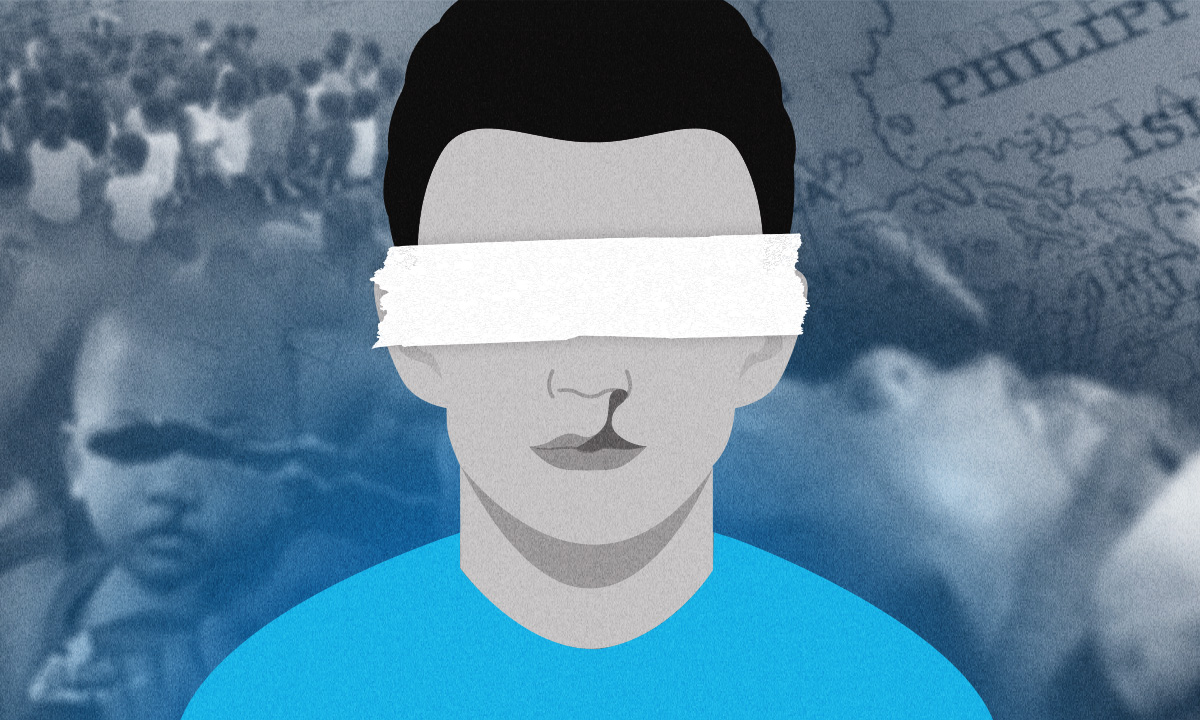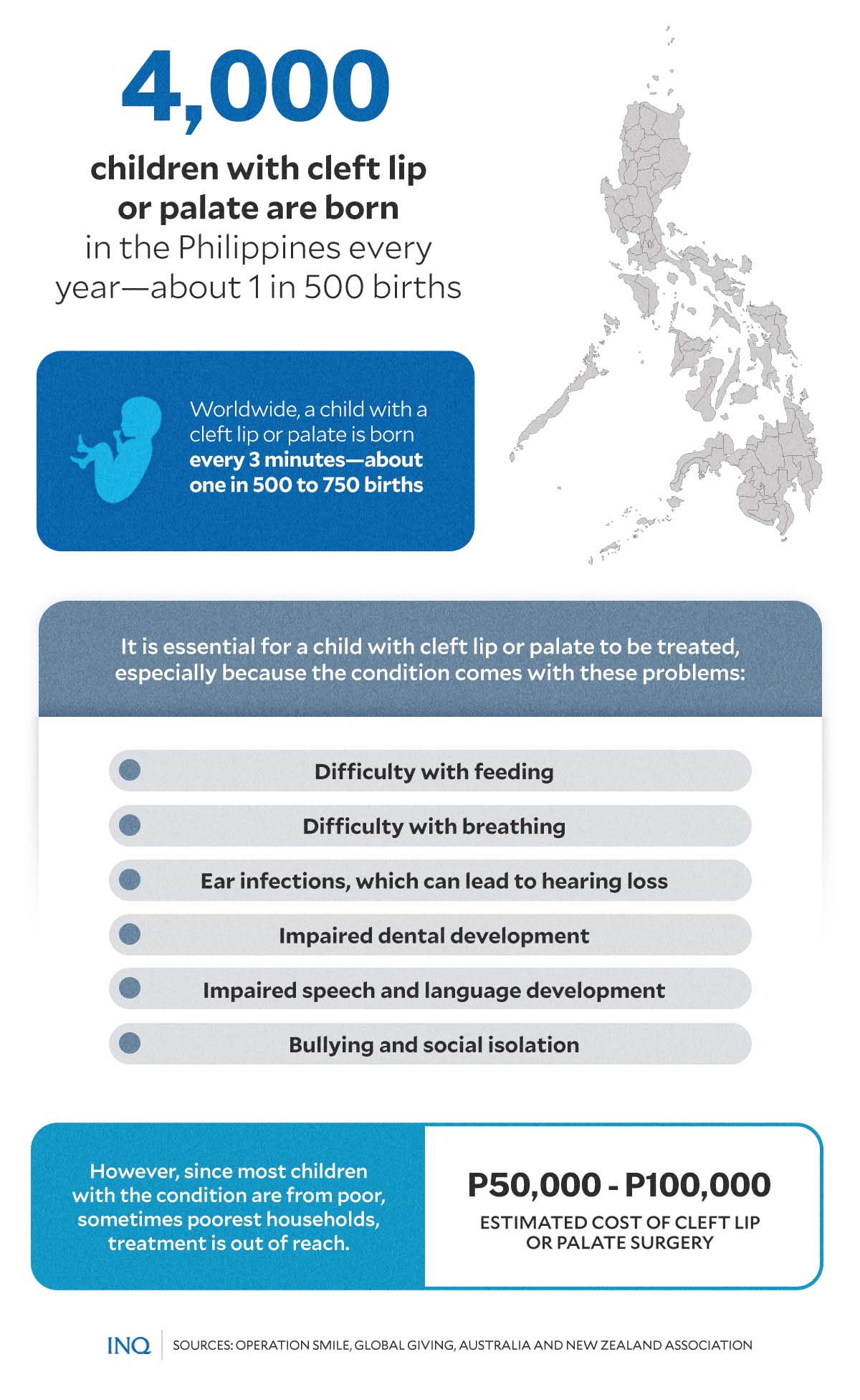Cleft Awareness Month: Access to surgery key to normal lives
MANILA, Philippines—One in 500 Filipino children have cleft lip or palate, but since most are from families stuck in poverty, thousands are believed to be living with their condition untreated.
They are the people left with no choice but to brave the difficulties that come with a gap in the lip or palate, which is the roof of the mouth, that did not close in the early stages of pregnancy.
All over the world, a child is born every three minutes with a cleft lip or palate—about one in 500 to 750 births, according to data from Operation Smile, an international NGO working to provide safe surgery, especially to those who are in need the most.
In the Philippines, 4,000 children are born with the condition every year, with most from extremely poor households, the NGO Abounding In Love said.
As explained by Operation Smile, depending on the type and severity, a cleft can cause serious health problems if not treated—the reason there is tireless work to make the world better, especially for people with cleft, one smile at a time.
Article continues after this advertisementGap in the lip, palate
Often, a cleft condition is easily seen because it is an opening in the lip, but sometimes it is harder to tell if someone has the condition because it is a gap in the palate.
Article continues after this advertisementAs explained by the US Centers for Disease Control and Prevention (US CDC), the lip forms between the fourth and seventh week of pregnancy, when body tissue and special cells from each side of the head grow toward the center of the face.
This joining of tissue forms the facial features, like the lips and mouth.
It said a cleft lip happens if the tissue that forms the lip does not join completely before birth, resulting in an opening in the lip, which can be a small slit or a large gap that goes through the lip into the nose.
The palate, meanwhile, is formed between the sixth and ninth week of pregnancy, and like cleft lip, a cleft palate happens if the tissue that makes up the mouth does not join together completely.
It was pointed out by the US CDC on its website that for some babies, both the front and back parts of the palate can be open, but for the rest, only a part of the roof of the mouth is open.
Why does it happen?
Operation Smile said there are many risk factors that can increase the likelihood of cleft, but while some causes are still unknown, these are said to have an effect on development inside the womb:
- Genetics and family history
- Pre-existing medical conditions
- Poor nutrition
- Exposure to harmful environmental substances
The US CDC said the condition is thought to be caused by a combination of genes and other factors, such as things the mother comes in contact with in her environment, or what the mother eats or drinks, or certain medications she uses while pregnant.
Understanding what causes the condition is really essential, it said, so it shared some significant findings from research studies about some factors that increase the chance of giving birth to an infant with cleft.
- Smoking: Pregnant women who smoke are more likely to have an infant with a cleft than those who do not smoke.
- Diabetes: Women with diabetes diagnosed before pregnancy have an increased risk of having a child with a cleft lip or cleft palate, compared to women who did not have diabetes.
- Use of certain medication: Women who used certain medicines to treat epilepsy, such as topiramate or valproic acid, in the first first three months of pregnancy have an increased risk of having an infant with the condition.
Lack of Vitamin B, or folic acid, could be a factor, too.
The US CDC said clefts, especially cleft lip, can be diagnosed during pregnancy by a routine ultrasound. They can also be diagnosed after the infant is born, especially cleft palate.
However, sometimes certain types of cleft palate, like submucous cleft palate and bifid uvula, might not be diagnosed until later in life, stressing that treatment depends on the severity, child’s age and needs, and associated syndromes or other conditions, or both.
Out of reach
Since 1982, Operation Smile Philippines has already conducted medical programs in over 95 cities and over 135 health care facilities, providing free consultations to 60,000 individuals and new smiles through free surgery to over 30,000.
Likewise, all over the world, including the Philippines, international NGO Smile Train has already provided safe and quality cleft care for millions of children with the condition.
Without them, treatment could still be out of reach for most individuals with cleft.
This, as based on data from Operation Smile, which was shared by the Australian and New Zealand Association (ANZA), the estimated cost of cleft lip or palate surgery is P50,000 and could go as high as P100,000.
This is too expensive for most of the population, ANZA said, pointing out that to date, there may still be more than 18,000 individuals living with untreated cleft conditions.
As stressed by Operation Smile, with surgery, a child with cleft can have a new smile, saying that ideally, a pediatrician and a plastic surgeon work with a child’s parents soon after the child’s birth to choose the best timing for the surgery.
Most surgeons agree that a cleft lip should be repaired by the time a baby is three months old, and that a cleft palate should be repaired between the ages of 12 and 18 months, it said.
However, for a lot of families in developing countries, early surgery may not be an option because of the lack of financial resources, qualified medical staff and other factors.
Treatment ‘essential’
As explained by Operation Smile, when one’s cleft is not treated, he or she can have difficulty with feeding, which can lead to malnutrition, or even starvation. There can also be difficulty with breathing.
Ear infections can occur, too, and recurring ear infections can lead to hearing loss.
Likewise, dental development can be affected, while speech and language development can also be impaired, Operation Smile said, stressing that one who has the condition may suffer, too, from bullying and social isolation.
It was stressed by Smile Train that cleft treatment alleviates many of these difficulties, ultimately enabling those with the condition to live normal lives.

